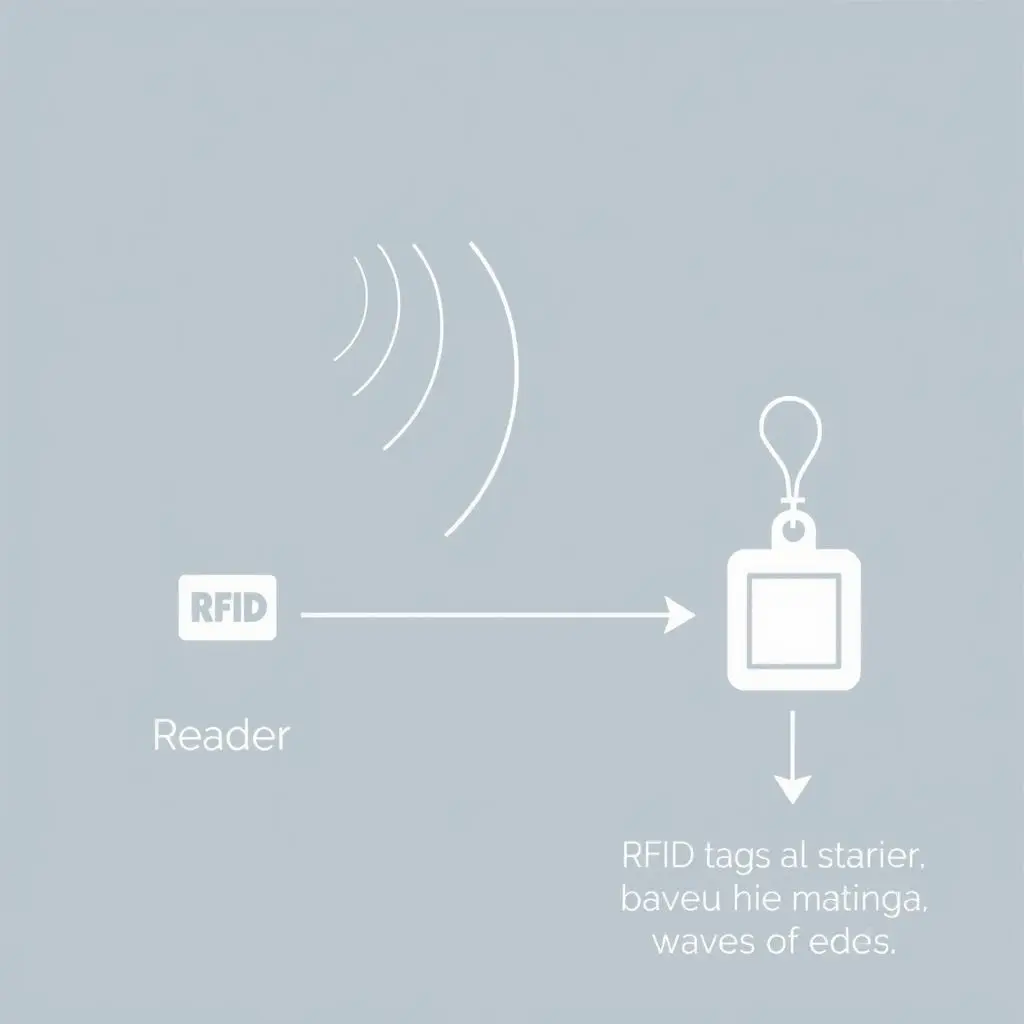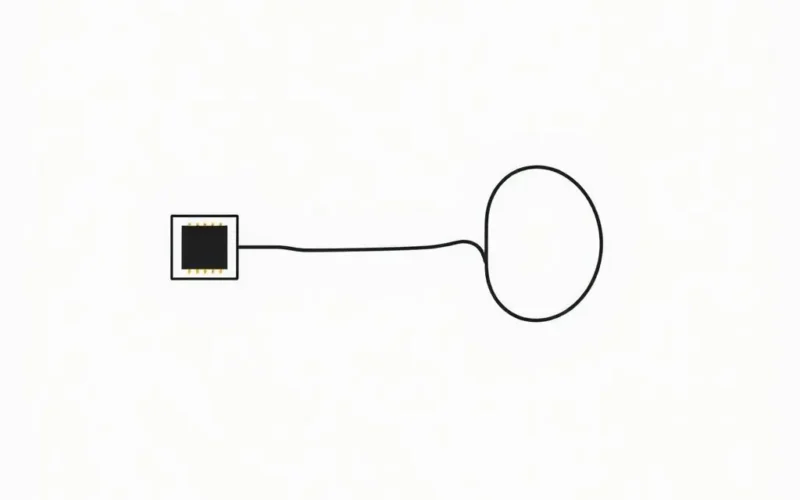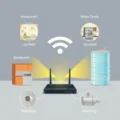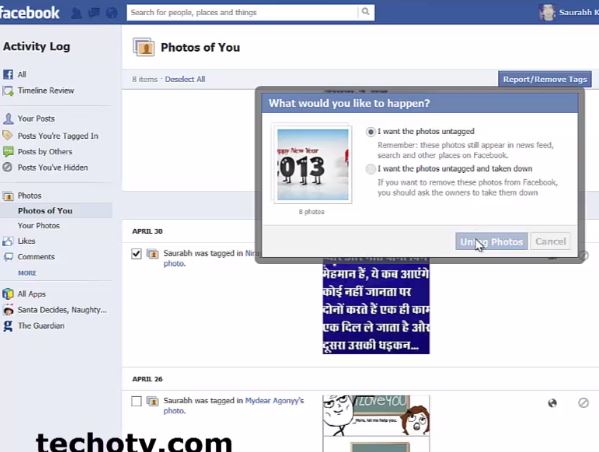Ever given a little thought to that tiny plastic fob on your keychain that effortlessly unlocks your car door? Or perhaps pondered how colossal warehouses manage to keep tabs on countless items without someone manually scanning every single box? This silent, behind-the-scenes wizardry is often the work of RFID – Radio Frequency Identification. Imagine minuscule digital identifiers that communicate using nothing but radio waves.
Unlike the familiar barcodes you need to point a scanner directly at, RFID tags operate on a different principle. They possess a diminutive antenna coupled with a microchip. When an RFID reader device emits a radio signal, the tag’s antenna cleverly captures energy from this signal. For passive tags, which make up the vast majority you encounter daily, this harvested energy is precisely what powers the chip to transmit its unique data back to the reader.
So, the sequence is straightforward yet ingenious: the reader ‘zaps’ the tag with radio energy, the tag ‘wakes up’ using that energy, broadcasts its specific identification information, and the reader instantly knows what item or object it’s interacting with. Crucially, passive tags require no internal battery, drawing all the necessary power from the reader’s signal. This fundamental interaction explains why warehouses can pinpoint the exact location of a particular widget or why your office entry barrier swings open just by bringing your access badge near the sensor. These tiny chips, indeed, wield a significant influence – that’s the essence of the RFID method.
Table of Contents
Peering Inside the RFID Ecosystem: Tags and Readers
At its heart, any RFID system comprises two primary components: the tag (often called a transponder) and the reader (sometimes referred to as an interrogator).
The RFID Tag is the identifier. Think of it as a digital license plate for an object. As mentioned, it contains two key parts:
- The Antenna: This element’s size and shape vary depending on the application and required read range. It captures radio waves from the reader and also broadcasts the tag’s response.
- The Microchip (Integrated Circuit or IC): This is the brains. It stores a unique identification number (often a long string of digits) and potentially other relevant data. In passive tags, it also manages the process of drawing power from the reader’s signal and modulating the antenna to send back the data.
Tags come in various forms – simple stickers, plastic cards, embedded chips, or robust casings built to withstand harsh environments.

The RFID Reader is the initiator of the communication. It’s the device that sends out radio frequency waves to activate the tags and listen for their responses. Readers can be stationary (like those at a warehouse dock door or retail exit) or mobile (like handheld scanners used in inventory audits). More sophisticated readers can communicate with multiple tags simultaneously within their read range.
The Core Mechanic: How Passive RFID Tags Get Their Power and Talk
While there are active RFID tags that have their own power source (like a small battery) allowing for longer read ranges and the ability to initiate communication, the passive tag is far more common and fundamental to many applications like key fobs and standard inventory tracking. Understanding how it works without a battery is key.
Here’s the magic:
- The Reader Emits Power: The RFID reader generates an electromagnetic field by sending radio waves through its antenna.
- The Tag’s Antenna Captures Energy: When a passive RFID tag enters this field, its antenna picks up the radio waves. The design of the antenna is crucial here – it’s tuned to the specific frequency the reader is transmitting on. This captured energy is converted into a small electrical current. This process is similar to how an old radio antenna picks up broadcast signals, but here, the energy is specifically intended to power the chip.
- The Chip Powers Up: The tiny electrical current generated by the antenna provides just enough power to activate the tag’s microchip.
- The Chip Modulates and Transmits Data: Once powered, the chip retrieves the unique identification number stored in its memory. It then subtly changes (modulates) the radio waves being sent *back* by the tag’s antenna. This modulation is essentially the tag encoding its data onto the reflected radio signal.
- The Reader Listens and Decodes: The RFID reader receives these modulated radio waves reflected back from the tag. It detects the subtle changes (the modulation), decodes them, and reads the unique ID transmitted by the tag.
- Processing the Data: The reader then sends this unique ID to a backend system (like a computer or database) where it is processed. This system looks up the ID and associates it with specific information – for a key fob, it’s linked to access permissions; for an inventory tag, it’s linked to product details, location, or status.

This entire ‘conversation’ happens almost instantaneously, often in milliseconds, allowing readers to process tags at remarkable speed and without a direct line of sight, provided the tag is within the reader’s range and orientation allows sufficient energy transfer.
RFID in Your Daily Orbit: Key Fobs and Beyond
The simplicity and efficiency of this passive power mechanism are why RFID has become so pervasive:
Key Fobs and Access Control
Your office badge, gym membership card, or car key fob often utilizes a passive RFID tag embedded within. When you hold the fob near the reader by the door or car ignition, the reader’s signal powers the tag, the tag sends its unique serial number, and the access system checks if that number is authorized. If it is, the door unlocks, or the car starts. It’s quick, contactless, and requires no battery replacement in the fob itself.
Inventory and Supply Chain Management
This is where RFID’s ability to read multiple tags simultaneously shines. Companies can attach RFID tags to individual items, cases, pallets, or even containers. Strategically placed readers at receiving docks, warehouse checkpoints, or loading bays can scan dozens or even hundreds of items in seconds as they pass by. This dramatically speeds up receiving, shipping, and inventory counts, providing real-time visibility into stock levels and locations without the need for manual scanning or unpacking.
![]()
Retail
Beyond the supply chain, retailers use item-level RFID tagging for faster, more accurate inventory checks on the sales floor, improved loss prevention (readers at exits detect unpaid items), and even enhancing the customer experience with smart mirrors or personalized recommendations based on items brought into a fitting room.
Library Systems
Libraries use RFID tags embedded in books for faster check-in and check-out processes and for security gate systems.
This invisible communication network is constantly expanding its reach, streamlining processes and enhancing convenience.
Want a Quick Peek at RFID’s Core Idea?
We’ve gone into a bit of detail here, but sometimes seeing the concept in action, even animated, helps solidify the understanding. We put together a quick visual explanation that boils down the core mechanism. Check it out:
The Upsides and a Few Considerations
RFID offers significant advantages over older identification methods like barcodes:
- No Line of Sight Required: Unlike barcodes, readers don’t need a direct view of the tag. Tags can be read through packaging, in cluttered environments, or from a distance.
- Faster Reading: Multiple tags can be read simultaneously, drastically increasing the speed of processes like inventory counting.
- Data Capacity: RFID tags can store more data than traditional barcodes, though passive tags typically store just an ID.
- Durability: Tags can be encased in protective materials, making them more resistant to environmental factors than printed barcodes.
However, there are factors to consider:
- Cost: RFID tags and infrastructure are generally more expensive than barcode systems.
- Interference: Radio waves can be affected by materials like metal and liquids, potentially reducing read range or preventing reads altogether.
- Privacy Concerns: Because tags can be read without your knowledge or consent from a distance, there are potential privacy implications, particularly with item-level tagging on consumer goods.
Frequently Asked Questions About RFID
Q: What’s the difference between passive and active RFID tags?
A: Passive tags get all their power from the reader’s signal and are cheaper and smaller, ideal for high-volume item tagging or access control. Active tags have their own battery, allowing them to transmit signals over much longer distances (hundreds of feet) and sometimes actively communicate their presence. They are more expensive and larger, typically used for tracking high-value assets or vehicles.
Q: Can anyone read my RFID tag?
A: An RFID tag can only be read by a compatible reader operating on the correct frequency within the tag’s read range. However, low-cost, portable readers exist, which raises privacy concerns. Some RFID systems incorporate encryption or other security features to mitigate unauthorized reading.
Q: Do RFID tags need batteries?
A: Passive RFID tags, which are very common (like in most key fobs or retail item tags), do NOT need batteries. They are powered solely by the radio energy from the reader. Active RFID tags, used for longer range applications, do contain batteries.
Q: Are there different types of RFID frequencies?
A: Yes, common frequencies include Low Frequency (LF, ~125 kHz), High Frequency (HF, 13.56 MHz), and Ultra-High Frequency (UHF, 860-960 MHz). Each has different characteristics regarding read range, data transfer speed, and susceptibility to interference, making them suitable for different applications. HF is common for access control and payment (NFC is a subset of HF), while UHF is dominant in supply chain and inventory management due to longer read ranges.
The Unseen Currents Shaping Efficiency
From the seamless access granted by your key fob to the intricate ballet of goods flowing through a global supply chain, RFID technology is a quiet but powerful enabler. Its ability to uniquely identify objects using invisible radio waves, especially the clever battery-free power mechanism of passive tags, has revolutionized various industries. It’s a prime example of how small, smart technology can lead to significant gains in efficiency, accuracy, and convenience in our increasingly connected world.





